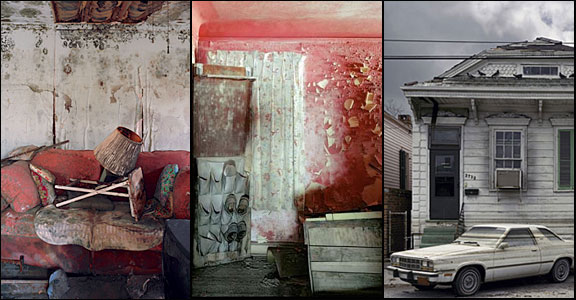Photography After the Flood
Photography After the Flood
Robert Polidori’s photographs of New Orleans.

Today, when we think of the hundreds of thousands of families who between 1935 and 1938 migrated to California after Dust Bowl conditions forced them off their farms in the Great Plains, we picture the men and women Dorothea Lange photographed during the years she worked for the New Deal’s Farm Security Administration. Primarily a portrait photographer until 1932, Lange found the skills that she had developed for the studio allowed her to capture the worn and tired faces of the “Okie” families trying to begin their lives again in the midst of the Great Depression.
Lange’s photographs quietly celebrated the Dust Bowl families who through no fault of their own found themselves without homes or work. In Lange’s most famous photograph, her 1936 “Migrant Mother, Nipomo, California,” a young mother stares straight into the viewer’s eyes, while her two young children, resting on her shoulder, look away as if shy or ashamed to be seen by strangers. The mother is shabbily dressed. The wrinkles on her sunburned face make her look older than she is. But like Ma Joad in John Steinbeck’s The Grapes of Wrath, Lange’s Migrant Mother is determined not to give in to despair. Her chin rests on her hand, but everything about her posture is straightforward. She does not avoid the camera. She challenges it. “I have done nothing to deserve the situation I am in,” she all but says.
Seventy years later, the men and women displaced from New Orleans by Hurricane Katrina have their own photographer of record—Robert Polidori, best known up to now for his photographs of Chernobyl after the Soviet nuclear power plant disaster of 1986. Polidori’s Katrina photographs have been collected in a massive 333-page book, After the Flood, and this fall twenty-four of them were featured in an exhibition that took up two separate galleries at New York’s Metropolitan Museum of Art.
The artistic differences between Lange and Polidori could not be greater. Polidori eschews black and white for bright chromogenic prints, and in the photographs at his Metropolitan Museum of Art show, people are missing. No corpses lie in the street. No suffering children beg for our attention. No heroic rescue workers search for the missing. Instead, at the center of Polidori’s New Orleans is an after-the-flood disaster of biblical proportions that continually challenges our sense of how the world is supposed to look.
Cars stand upside down, their rear bumpers leaning against the gutter of a roof. Uprooted trees rest on houses that seem as if they were built from a plywood kit. In contrast to the familiar World War II photos of bo...
Subscribe now to read the full article
Online OnlyFor just $19.95 a year, get access to new issues and decades' worth of archives on our site.
|
Print + OnlineFor $35 a year, get new issues delivered to your door and access to our full online archives.
|





